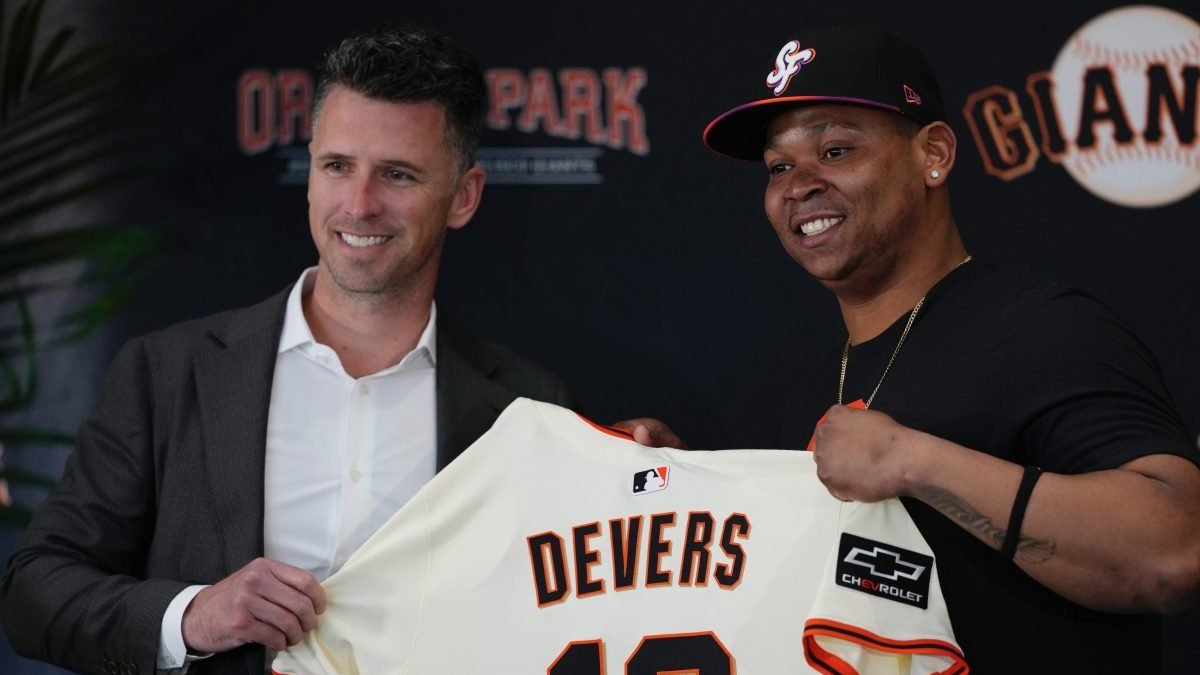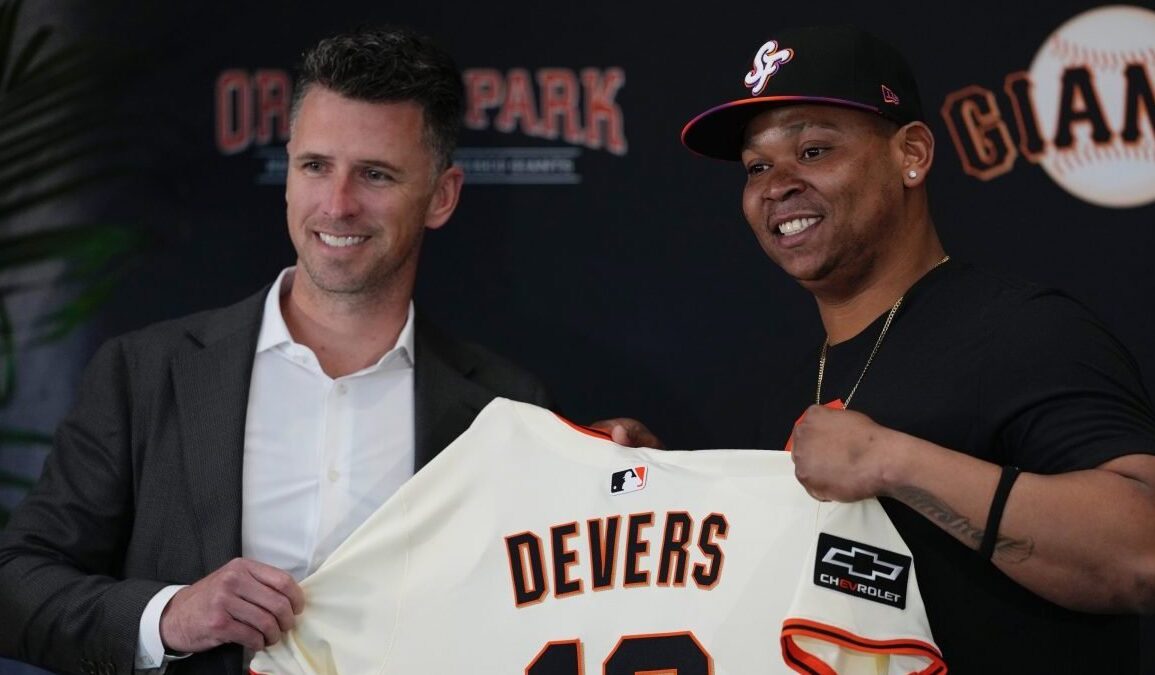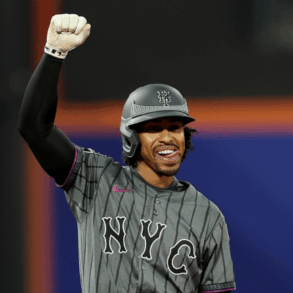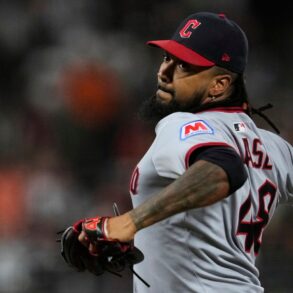
SAN FRANCISCO — It all started with a text message.
About a month ago, Giants president of baseball operations Buster Posey needed to talk to Boston Red Sox chief baseball officer Craig Breslow about something minor, but there was something else that he couldn’t stop thinking about. He opened his group chat with general manager Zack Minasian and assistant general manager Jeremy Shelley and asked a question that would transform the future of the team they run.
“Do you guys think I should ask about Devers?” he wrote.
Both Minasian and Shelley pressed down on the message and waited for their options to pop up. Both clicked on the “thumbs up” emoji.
What followed was one of the quietest pursuits of a superstar in MLB history, one that shocked the industry on Sunday, when Rafael Devers was traded to the Giants as they were preparing to face the rival Los Angeles Dodgers on Sunday Night Baseball. Two days later, Devers was introduced on the club level at Oracle Park during a press conference that was attended by his new teammates and set them on a new path, one that Posey believes will bring a championship back to San Francisco.
The first three since the team moved West are largely because of Posey. If there’s a fourth, it might be traced back to that text message and the month that followed. There were stops and starts, but the Giants kept pushing. They wanted to avoid the madness of the MLB trade deadline, which led to a situation that’s just about unprecedented. On June 15, six weeks before the deadline, they acquired Devers for pitchers Kyle Harrison and Jordan Hicks, along with two prospects.
“I give Buster a lot of credit. He seemed very determined,” Minasian said Tuesday. “He worked pretty hard at it with Craig Breslow. There’s always ups and downs to these conversations, but he wanted to see it through. Our baseball operations group wanted to see it through. We’re just thrilled this was the outcome.”
As with most major life decisions, the initial thought quickly had to escape the group chat. Two weeks ago, during a home game against the Atlanta Braves, Posey, Minasian and Shelley met with chairman Greg Johnson in the front office’s suite at Oracle Park. Acquiring a player owed roughly $255 million over the next eight and a half seasons would require early buy-in from ownership, but Johnson already was on the same page.
Late last month, as the Giants were getting swept by the Detroit Tigers, Johnson and Minasian had a conversation about the offense, which went 16 straight games without scoring more than four runs at one point. Johnson watched the offense flounder and mentioned to his general manager that they needed a bat. A few days later, as they sat in the booth and discussed Devers, Minasian smiled.
“I said, ‘Did you think we were going to come to you with a bat controlled for the next eight years?'” he recalled.
Posey’s ambition did not catch Johnson by surprise. The president of baseball operations is also a member of the ownership group, and he had started to set the stage for taking on what will be the biggest contract in franchise history. Plus, there was no doubt in anyone’s mind about what the roster needed. Johnson called the hole in the lineup “obvious” and noted that the organization is thrilled with how all of the young pitching has developed. The window to contend opened sooner than most expected.
As Johnson sat with his baseball operations team, he asked about the short- and long-term implications.
“We’ve got what’s in front of us, the opportunity, but we’ve also got to look down the road, as well, for the group,” Johnson told NBC Sports Bay Area. “We talked a lot about that and there have been deals we didn’t do by that process, where we all got together and went around and everybody was just a little, ‘Well, maybe not’ and we just kind of killed it at the last minute. That was kind of the start and we just rolled from there.”
It was not, however, an entirely smooth process.
The Red Sox, per sources, began negotiations by asking for top prospect Bryce Eldridge. The Giants considered him 100 percent off-limits, and eventually the conversation turned to players like Hayden Birdsong, Carson Whisenhunt, Harrison and 2024 first-rounder James Tibbs. The front office eventually parted with two of them, but the Red Sox initially pushed for a larger group. Johnson said negotiations “stalled” several times.
“I called their ownership group and just said, ‘We’re serious about this, and I think you guys are maybe pushing a little too hard in players that they want as part of the deal,'” he told NBC Sports Bay Area. “There were times where it looked like it was dead and then it came back online. We just kept the dialogue alive. I think just putting the pressure [on] — we weren’t going to be around at the deadline. We wanted to make it clear to them that if this deal gets done, it gets done in the next few weeks. We’re not going to drag it out and we’ll move on to something else. I think that was very important.”
The stunning timing of the deal led many in the sports world to compare it to the Luka Dončić trade, and if there’s an element that’s particularly similar, it’s that desire from the Giants to get the deal done early and avoid a bidding war, and their ability to convince the Red Sox to follow the same path.
The Giants felt the Red Sox were motivated to simply move on from Devers, who did not see eye to eye with management. Getting it done early allowed them to avoid the noise of the deadline, and the awkwardness that would come with potentially not trading Devers after rumors got out.
The Red Sox likely could have found better prospect hauls elsewhere, but the Giants had a key card to play. They were willing to take on the entirety of Devers’ contract. Does the deal get done if they don’t do that?
“No,” Johnson said.
The Giants’ own sense of urgency was pushed by their lack of offensive thump, and in the end, after a month of back-and-forth, the deal came together quickly. Posey was on the road trip but flew home Sunday to be with his family. He has joked during his tenure as an executive that the hardest part is always being on the phone, and on Father’s Day, he took calls as he watched his four children run around the backyard.
Minasian had plenty of conversations in recent weeks with Red Sox VP of Baseball Operations Brian O’Halloran, but they both knew that at some point the ball would be turned over to Posey and Breslow. On Sunday morning, Posey informed Minasian that they were close. Thirty minutes before first pitch later that day, Harrison was told to leave the field, where he had been preparing to start against the Dodgers.
The deal was a shock to most of the clubhouse, but manager Bob Melvin had known for some time that it was in the works. His big concern Sunday was about what to do with his lineup card. Major League Baseball asks that an official version gets turned into their computer system at least half an hour before first pitch, but Melvin stalled because he knew Posey was on the phone with the Red Sox. With players starting to stretch, Posey told Melvin to turn in a card without Harrison on it.
The paperwork was fully approved by MLB a couple of minutes before first pitch, and as players prepared for the Dodgers, word spread that they had a new face of the franchise. Two days later, Devers arrived and got a standing ovation in his first at-bat. In an early reminder that this isn’t Boston, he also heard cheers after striking out.
In the 48 hours between the trade becoming official and Devers getting introduced at Oracle Park, the Giants sold thousands of additional tickets, and you can’t ignore that part of this. They are up about 2,500 fans per game without even getting the annual boost of kids being out of school yet, and on the last homestand, as negotiations went on, they drew more than 35,000 to six of seven games. On the day that the front office met to discuss Devers, they sold out Oracle Park.
The vibes changed in October when the Giants made Posey their president of baseball operations. That has carried over through a winning first half, and they’re hopeful that the Devers addition takes them to the next level, where they were for most of Posey’s playing career.
“It speaks to what Buster has done, the tone he has set with the organization, bringing Willy [Adames] in and how he has just been a tremendous clubhouse presence,” Johnson said. “Obviously part of our comfort level in getting this deal done is how fans have been so engaged and showing up at the park. That helps, I think, the board and ownership group make this kind of commitment, when we see that kind of commitment coming from our fans.”
Download and follow the Giants Talk Podcast
This post was originally published on this site be sure to check out more of their content.







